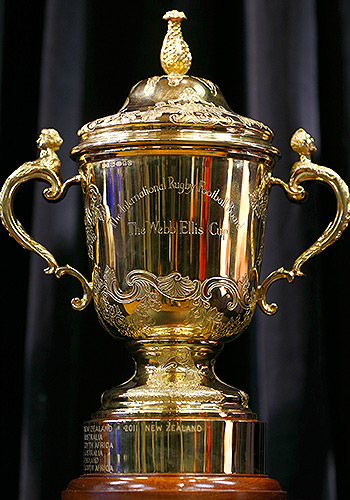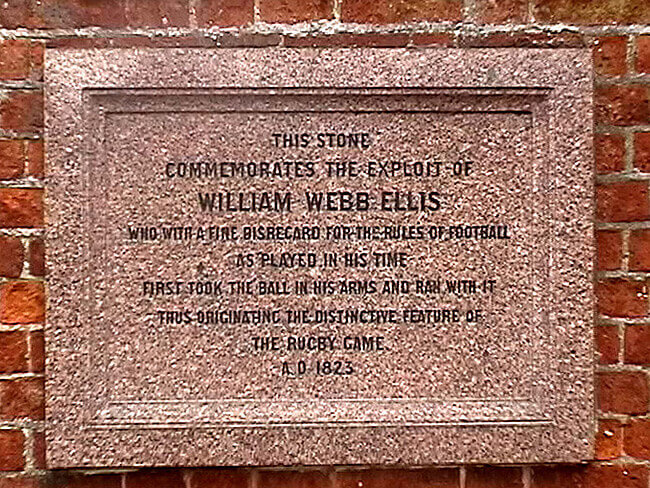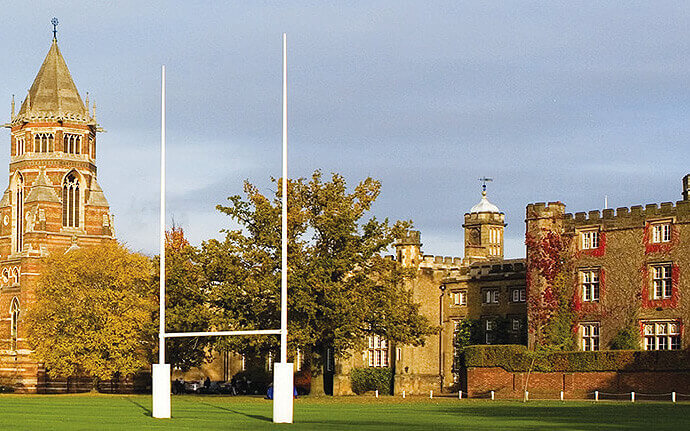William Webb Ellis - Part Two
In the shrinking school a boy of reasonable academic and sporting ability, such as Ellis, would have been important. Rugby School, in common with many British public schools, had a great divide between staff and boys, the boys despising the staff. The headmaster was an autocrat and the boys themselves would have a system in which the strong ruled over the weak. Rugby School had a system of praeposters brought to the school from Eton by Dr T James.
The praeposters exercised authority over the boys, often in a barbaric way in the days when fagging and flogging were common. James exercised no authority over praeposters. He was succeeded in 1794 by Henry Ingles, known as the Black Tiger.
In 1797 the boys revolted against Ingles. Explosives were used and eventually the militia were called out and the Riot Act read. Ringleaders were expelled and many more mutineers severely flogged. In 1806 Wooll succeeded Ingles. Wooll did nothing to curb the praeposters though he did rid the school of some of the worst excesses. In 1822 fags rebelled against praeposters and masters. 
When the protracted affair came to an end, some were expelled and some withdrawn. Thomas Arnold took over from Wooll in 1828 and was headmaster at his sudden death in 1842, on the day before his 47th birthday. Arnold replaced praeposters by prefects and charged them with moral guardianship of the school.
This was William Webb Ellis's school. He left the school in 1825, three years before Arnold arrived, and went up to Oxford as an exhibitioner to Brasenose College. An exhibition was a scholarship, which suggests that Ellis was no slouch academically. He in fact received the second Rugby exhibition, worth £60 per annum at a time when a schoolmaster received about £15 per annum.
Whether he played football at Oxford is unknown but in 1827 he batted number three for the university against Cambridge, in days before Blues were awarded.
In 1829 he received the BA degree, in 1831 the MA. In 1847 he also received an MA from Cambridge by incorporation.
Down from Oxford, the Rev. WW Ellis became minister of St George's in Albermale Street, London, and then rector of St Clement Dane's in the Strand. His mother lived with him there and died there. He placed a memorial to her in the church which was destroyed by German bombs in World War II. After the war the church became the church of the RAF whose rugby union erected a tablet in memory of Ellis. For the last 17 years of his life he was rector of Laver Magdalen, now Magdalen Laver, in Essex.
He never married, preached a sermon during the Crimean War which attracted attention and resulted in a daguerreotype in the Illustrated London News, the only available image of him. His only published work was a sermon on King Asa's Prayer on the Eve of Battle, preached in the morning in St George's and in the evening, in St Clement Dane's on 26 April 1854.
He may also have written a poem in praise of beer.
When he died he left an amount of £9000, which meant he was wealthy. He died at Menton in the Alpes Maritimes in the south-east of France, on 24 January 1872, there apparently for his health. Ross McWhirter found his grave in October 1959.
During the 2007 World Cup the IRB visited the grave and placed a memorial there. Billy Beaumont, the vice-chairman of the IRB and a former Lions and England captain, carried out the ceremony.
In Ellis's schooldays sport was organised and run by senior boys and everybody joined in a Big Side on the Close, which is still there and where the tablet now is. The game they played was not soccer, but Rugby Football – a form of football unique to Rugby School. Its rudimentary rules were the property of the players and decided on from time to time by agreement amongst the senior boys.
The ball was handled from time to time. Usually that was to make a mark from an opponent's kick which allowed the catcher a free kick. Normally the catcher would then move backwards as the opponents were allowed to take up a position on the mark, as situation which obtained in rugby football for many, many years. Ellis may well have caught the ball and run forward with it. Running in to get a shot at goal was not uncommon. The great exponent of this was Jem Mackie in the late 1830s. The point is that games were haphazard and unrecorded.
But in 1895 Rugby School erected its tablet about his feat. This was seventy two years after the event, 23 years after Ellis had died. The man who did the investigation in to the origins of the running game was MH Bloxam, an Old Rugbeian who had left rugby in 1821. But Bloxham's brother was an exact contemporary of Ellis's.
There are doubts about the validity of all this, the unlikelihood of a single act by one fellow to change the game, and a boy not renowned for his footballing prowess at all.
One theory is that all of this was produced in 1895 as a counter to the dispute about broken time payment in Yorkshire and Lancashire, strong parts of rugby football but where men needed to take unpaid time off work to pay in the days of a six-day working week and a sport-less Sunday.
There had been representation from the men of the mines and the mills that they be compensated for wages lost in order to play the game at which gate money was charged. It is just possible that this plaque was installed at rugby school to show that the game had originated in clean air on a green field through the Damascus Road-style revelation to a young, innocent public schoolboy, not in the hearts of grouchy miners grubbing for money in the dark bowels of the earth.
This was also the age of invention. There was Stephenson with his locomotive, Watt, Faraday, Davy with his lamp, Lister, Alexander Bell and so on. After all individuals did things – discovered new countries and sea routes. Having an individual inventor and a single act added to the greatness of the game. That little was known about him added to the mystique and meant that there could be no grubby revelations about him.
Were the men who chose Ellis thus filled with devious intent? Highly unlikely. Bloxham seems to have been an honourable man and a noted antiquarian. Perhaps, like many myths, there is more truth in the affair than people think.
On 1 November 1923 a centenary match was played on the Close at Rugby School. England and Wales combined (seven and eight) against Scotland and Ireland (eight and seven), refereed by an Old Rugbeian, VH Cartwright, who had captained England. There were about 2000 spectators, including the 600 boys of the school.
It was a dramatic match which England-Wales won 21-16, though Scotland-Ireland scored four tries to three. Two dropped goals made the difference for the winners.
Fact File
Full names: William Webb Ellis
Birth: Salford, England, 24 November 1806.
Education: Rugby School and then Brasenose College, Oxford
Occupation: Clergyman
Playing career: School only
Death: Menton in the Alpes Maritimes in the south-east of France, 24 January 1872. Ross McWhirter found his grave in October 1959.
When the RFU was founded in 1871, the man behind the moved was Edwin Ash, an Old Rugbeian. England then played Scotland in the first-ever test. They wore Rugby School's jerseys, which were white. The teams were 20 a-side in that first test. The England side contained ten Old Rugbeians.
HH (Herbert Hayton) Castens was an Old Rugbeian though born in the Eastern Cape. He captained South Africa in its first-ever test in 1891 and then refereed the last test of that series. A wicketkeeper-batsman, he captained the first South Africa cricket team to tour abroad.
Adrian Stoop, who developed specialised halfback play, was an Old Rugbeian.
Algernon Rutter, the first president of the RFU, Frederick Stokes, the second president of the RFU at the age of 24, Leonard Mattoon, the third president who with Rutter was largely responsible for drafting the 1871 laws, Charles Heatley, the fourth president, and Arthur Guillemard, the fifth president, were all Old Rugbeians. Rutter twice re-elected as president, Heatley once and Guillemard three times. Stokes and Guillemard played for England, Stokes while president. Guillemard also refereed internationals.
In the first Varsity Match, played 20 a-side, there were 16 Old Rugbeians in the Oxford side and 8 in the Cambridge side.
In 1839 Queen Adelaide visited Rugby School. They played a match – School House vs the Rest which meant 75 vs 225. In the queen's honour School House wore red velvet caps. This is the origin of the practice of capping players.
A player who received his cap was Rupert Brooke, the poet, whose father lived in the vicarage at Granchester, recently the home of Lord Archer, who, apart from writing successful novels and getting into scrapes, was a keen rugby follower.
Hacking was very much a part of football at Rugby School, and players even had metal toecaps on their boots to enable them to hack more viciously. These boots were sometimes called navvies.
Frederick Temple, later the Archbishop of Canterbury, was for a while headmaster of Rugby School. Asked if he ever thought of stopping the game at Rugby, he replied: "Never, short of manslaughter."
By Paul Dobson
@rugby365com




































